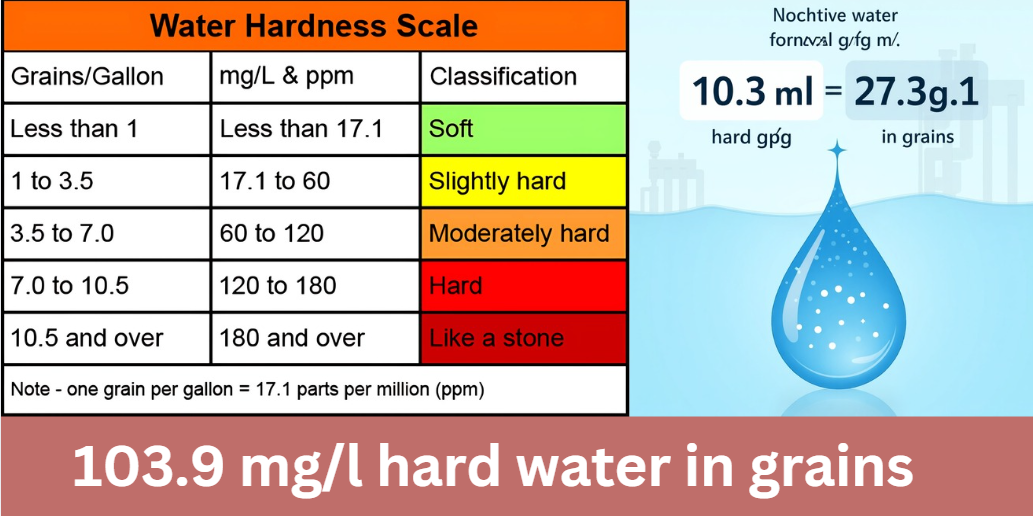The Ultimate Comprehensive Guide to 103.9 mg/l hard water in grains
Water hardness refers to the concentration of dissolved minerals, mainly calcium and magnesium, in your water supply. The measurement 103.9 mg/l hard water in grains is an important metric that tells you how hard your water is.
This guide is written in easy-to-understand language, ensuring that whether you are a homeowner, a water treatment professional, or simply curious, you can grasp the concept quickly. We will cover the origins of water hardness measurements, conversion methods, real-life implications, testing methods, and practical solutions for managing hard water.
Background on Water Hardness
Water hardness is more than just a numerical value; it directly affects the quality of your water and the performance of household appliances. The presence of minerals like calcium and magnesium can influence the taste of your tap water, lead to scale buildup in pipes and water heaters, and affect the efficiency of soaps and detergents.
When you encounter a measurement such as 103.9 mg/l hard water in grains, it represents the total concentration of these minerals in your water. This understanding helps in evaluating whether you need a water softening system or other corrective measures.
Historically, water hardness has been measured in various units, and its impact has been a critical factor in the development of water treatment solutions. Many regions have specific guidelines and standards to maintain water quality, making the accurate measurement of water hardness crucial.
Understanding Units of Measurement
Water hardness is commonly expressed in two units: milligrams per liter (mg/l) and grains per gallon (gpg). The value 103.9 mg/l hard water in grains can be converted to provide a more familiar perspective for those used to the traditional unit of grains per gallon. In essence, 1 grain per gallon is approximately equivalent to 17.1 mg/l. This conversion is standard among water quality experts and is widely accepted in both industry and research.
For clarity, consider the following table:
| Measurement (mg/l) | Conversion Factor | Result (gpg) |
|---|---|---|
| 103.9 mg/l | ÷ 17.1 | ≈ 6.08 gpg |
This table helps illustrate the direct conversion and allows you to quickly understand the hardness level in a unit that might be more familiar to you.
Conversion Methodology and Calculation
The conversion process is straightforward yet essential for interpreting water quality data accurately. To convert 103.9 mg/l hard water in grains into grains per gallon, you perform the following steps:
- Identify the Measurement: Start with the given value of 103.9 mg/l.
- Apply the Conversion Factor: Divide 103.9 by 17.1, which is the standard factor.
- Interpret the Result: The result is approximately 6.08 gpg, indicating a moderate to hard water level.
This method is widely used by professionals and can be applied to any water hardness measurement to assess the need for water treatment solutions.
Practical Implications of 103.9 mg/l hard water in grains
The measurement 103.9 mg/l hard water in grains has practical implications that can affect both everyday living and long-term maintenance of household systems. For instance, water with this hardness level can lead to:
- Scale buildup in pipes and water heaters, reducing their efficiency and lifespan.
- Reduced effectiveness of soaps and detergents, leading to higher usage and costs.
- Potential impacts on skin and hair, such as dryness or irritation due to mineral deposits.
Consider a scenario where a homeowner notices white, chalky deposits around faucets and on dishes. These deposits are a clear sign that the water contains a high mineral content, as indicated by 103.9 mg/l hard water in grains. By understanding this measurement, homeowners can better decide whether to invest in a water softening system to mitigate these issues.
Impact on Health and Household Appliances
The effects of hard water extend beyond visible scale deposits. In households with 103.9 mg/l hard water in grains, appliances such as washing machines and dishwashers may experience reduced performance due to mineral buildup. Over time, this buildup can lead to increased energy consumption and higher maintenance costs.
Moreover, hard water can affect personal care routines. For example, the minerals present in hard water might leave a residue on skin and hair, causing dryness or irritation. By monitoring the water hardness level, individuals can take proactive steps to adjust their cleaning routines or consider using water conditioners.
How to Test Your Water Hardness
Testing your water hardness is a simple yet essential process that helps you determine whether your water falls within acceptable standards. There are several methods available, ranging from quick at-home test kits to professional laboratory analysis. Here is a brief overview of the available methods:
- At-Home Test Kits: These kits are affordable and easy to use, allowing you to get a quick estimate of your water hardness.
- Digital Water Meters: Digital meters provide a more precise measurement and are often used by professionals.
- Laboratory Analysis: For the most accurate results, you can send a water sample to a certified laboratory.
The following table summarizes the pros and cons of each testing method:
| Testing Method | Accuracy Level | Ease of Use | Cost |
|---|---|---|---|
| Test Strips | Moderate | Very Easy | Low |
| Digital Meters | High | Easy | Moderate |
| Lab Analysis | Very High | Requires Sending | High |
By choosing the appropriate method based on your needs and budget, you can accurately assess whether your water quality corresponds to levels such as 103.9 mg/l hard water in grains.
Regional Variations and Standards
Water hardness can vary significantly depending on geographic location. Different regions have varying standards for what constitutes soft, moderately hard, or very hard water. The value 103.9 mg/l hard water in grains typically falls within the moderate to hard range in many parts of the world. Understanding these regional differences is crucial, especially when comparing water quality standards and the necessity for treatment systems across various areas.
This section also discusses how local utility providers and government agencies set guidelines to ensure that water quality meets health and safety standards, ultimately affecting consumer choices.
Tips and Solutions for Hard Water Issues
Managing hard water is possible with the right tools and strategies. Homeowners dealing with 103.9 mg/l hard water in grains can benefit from various solutions designed to reduce the adverse effects of mineral buildup. Installing a water softener is one of the most effective methods to combat hard water issues. Additionally, routine maintenance such as cleaning appliances and using descaling agents can significantly mitigate the impact.
For example, consider these practical tips:
- Install a Water Softener: A water softener system can exchange calcium and magnesium ions for sodium or potassium ions, reducing hardness.
- Regular Appliance Maintenance: Routine cleaning helps remove scale deposits and extends the lifespan of appliances.
- Use Descaling Products: Special cleaning agents can help remove existing scale from fixtures and surfaces.
These solutions not only improve the efficiency of household appliances but also enhance the overall quality of life by reducing the negative effects of hard water.
Frequently Asked Questions
How often should I test my water hardness?
While the main article explains how to test water hardness, it does not specify frequency. It is generally recommended that homeowners test their water hardness at least once a year, particularly if they notice changes in water clarity, scale buildup, or after any modifications in their water supply infrastructure. In areas with fluctuating water sources or seasonal changes, more frequent testing might be beneficial to ensure consistent water quality.
What is considered the ideal water hardness level for optimal appliance performance?
The optimal range for water hardness can vary, but many experts suggest that water falling within the range of 60–120 mg/l (or roughly 3.5–7 gpg) tends to minimize scale buildup and maintain appliance efficiency. Although 103.9 mg/l hard water in grains falls within the moderate to hard range, understanding this ideal spectrum helps homeowners decide if further treatment or regular maintenance is necessary for their specific appliances.
How do different water treatment systems compare in terms of effectiveness and environmental impact?
Beyond the basic use of water softeners discussed in the article, there are several treatment systems available, such as reverse osmosis, ion exchange systems, and magnetic water conditioners. Each system varies in its efficiency, initial cost, and environmental footprint. For instance, while ion exchange softeners are highly effective in reducing hardness, they can generate salt brine that must be disposed of responsibly. In contrast, reverse osmosis systems not only soften water but also remove other impurities, although they tend to have higher energy requirements and maintenance costs.
What are the long-term economic impacts of using hard water in a household?
Persistent exposure to hard water can lead to gradual degradation of appliances, increased energy consumption, and higher maintenance or repair costs. Although the article touches on scale buildup and appliance wear, this FAQ emphasizes the potential cumulative financial burden over time. Investing in a proper water treatment system might incur an upfront expense, but it often results in reduced long-term costs by extending the lifespan of appliances and improving overall efficiency.
Are there any health benefits or concerns associated with consuming hard water?
While the article notes that hard water is generally safe to drink, some studies suggest that water containing moderate levels of calcium and magnesium (minerals contributing to water hardness) may offer dietary benefits. However, extremely hard water can sometimes affect the taste and may lead to minor digestive discomfort for sensitive individuals. Ongoing research continues to explore whether there are any significant long-term health implications, but most experts agree that moderate hardness is not a major health risk.
Conclusion
In summary, this comprehensive guide has covered everything you need to know about 103.9 mg/l hard water in grains. We explored the concept of water hardness, explained the conversion from mg/l to grains per gallon, and discussed the practical implications for both health and household appliances.
Additionally, we reviewed various testing methods and provided actionable solutions for managing hard water. By understanding these concepts, you can make more informed decisions about water treatment and maintain a better quality of life. We hope this guide serves as your go-to resource for navigating the complexities of water hardness, ensuring that you can tackle any hard water challenges with confidence.
Recommended posts
Comprehensive Guide to rpdjafud: The Ultimate Resource for Digital Security & Innovation
Comprehensive Guide to apply waxillgro279 product
Learning the 9 Most Amazing Things 5-Year-Olds Accomplish 2020 STJCC
Rhythmical Bossa ONJ3: The Ultimate Guide to a New Era of Bossa Nova Fusion
eye_rene845: The Digital Influence Shaping Eye Health Awareness






